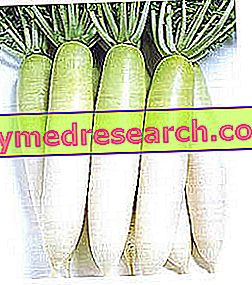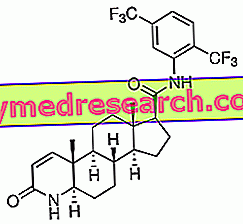Introduction
Many people praise daikon as a delicious side dish with even extraordinary therapeutic properties. In this article we will try to shed light on the characteristics and properties of this strange root, little known in Italy until a few years ago, but extremely widespread in Japan.
Generality

Daikon is a white edible root commonly known as white radish or Japanese radish ; in Japanese, the term daikon means "big root". In the United Kingdom and throughout Asia, daikon is commonly known as mooli .
In folk medicine, it seems that daikon is a panacea for all purposes.
Botanical analysis
In botany, daikon is known as Raphanus sativus var. longipinnatus, and among the countless existing varieties the most important is certainly aokubi daikon (Fam. Brassicaceae). As we have seen, it is a root morphologically comparable to the carrot, but which reaches lengths of 20-35 centimeters and a diameter of 5 or even 10 centimeters.
The flesh is fleshy, while the thin external coating (commonly called peel) is shiny.
The Korean radish, another variant of the daikon, has a shorter length than the previous one and its color is light green. The Japanese daikon needs not too high temperatures, unlike the Chinese one, able to survive even in areas with a warmer climate. Moisture and altitude greatly affect the quality of crop yield: in unsuitable conditions, with a low degree of humidity and excessive temperatures, the root is too hard and woody, consequently it loses its commercial value.
Food uses
The daikon plays a leading role in the Japanese diet: it is used mainly grated to prepare salads, but its use is also known in the decoration of dishes based on sashimi or natto (food preparation obtained by fermenting soya beans ).
Furthermore, the daikon is used for the preparation of soups, soups and stews.
Daikon is also widely used in Chinese, Vietnamese and Indian cuisine, while in Italy its use is not very common.
Daikon in the Pan with Vegetables
X Problems with video playback? Reload from YouTube Go to Video Page Go to Video Recipes Section Watch the video on youtubeTherapeutic properties
It seems that daikon has extraordinary therapeutic properties:
- The grated daikon has the specific property of favoring the digestion of fried foods or foods rich in fat: it is no coincidence that the consumption of daikon is recommended at the end of a hyperlipidic meal.
- The daikon root is also attributed properties in dissolving excess fat deposits.
- It seems that the consumption of daikon is a valid aid against liver disorders.
- Used in herbal medicine, daikon boasts mild diuretic, draining and purifying properties of the urinary tract.
Daikon is a food with a very low calorie content: 100 grams of root provide only 90 kjoules (22kcal), but it is rich in vitamin C (100 g of food: about 34% of RDA).
Summary
| Daikon: description | White edible root, commonly known as white radish or Japanese radish : a delicious side dish with therapeutic properties |
| Daikon: nomenclature | In Japanese, the term daikon means "big root" In the United Kingdom and throughout Asia, daikon is commonly known as mooli Botanical name: Raphanus sativus var. longipinnatus |
| Daikon: botanical description | Fam: Brassicaceae Description: morphologically comparable root to the carrot (lengths of 20-35 centimeters, diameter of 5 or even 10 centimeters) Meaty pulp Thin external coating (commonly called peel): shiny |
| Daikon: variety |
|
| Daikon: factors that affect quality | Humidity and temperature Poor humidity and excessive temperature → hard and woody root → loss of quality |
| Daikon: food uses |
|
| Daikon: therapeutic properties |
|
| Daikon: calories and vitamins | 100 g of daikon provide about 22 kcal and provide 34% of RDA of vitamin C |



